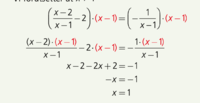Mayapotter00
New member
- Joined
- Nov 13, 2020
- Messages
- 5
Hi guys,
This is an example from my math book explaining rational equations, however, when I tried multiplying the common denominator (which is x-1) all of a sudden we don't multiply it with -2, and I wonder why? Actually I don't understand the example at all, could someone explain the steps for me?
Thank you so much!!!
This is an example from my math book explaining rational equations, however, when I tried multiplying the common denominator (which is x-1) all of a sudden we don't multiply it with -2, and I wonder why? Actually I don't understand the example at all, could someone explain the steps for me?
Thank you so much!!!


